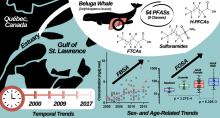| Title | Prioritizing molecular formulae identified by non-target analysis through high-throughput modelling: application to identify compounds with high human accumulation potential from house dust. |
| Publication Type | Journal Article |
| Year of Publication | 2023 |
| Authors | Zhang, Z, Li, L, Peng, H, Wania, F |
| Journal | Environ Sci Process Impacts |
| Date Published | 2023 Oct 16 |
| ISSN | 2050-7895 |
| Abstract | Because it is typically not possible to pursue compound identification efforts for all chemical features detected during non-target analysis (NTA), the need for prioritization arises. Here we propose a strategy that ranks chemical features detected in environmental samples based on a model-derived metric that quantifies a feature's attribute that makes it desirable to elucidate its structure, , a high potential for bioaccumulation in humans or wildlife. The procedure involves the identification of isomers that could plausibly represent the molecular formulae assigned to NTA-detected chemical features. For each isomer, the prioritization metric is calculated using properties predicted with high-throughput methods. After the molecular formulae are ranked based on the average values of the prioritization metric calculated for all isomers assigned to a formula, the highest ranked molecular formulae are prioritized for structure elucidation. We applied this workflow to features identified in house dust, using the ratio of chemical intake through dust ingestion to chemical concentration in blood (dose-to-concentration ratio, DCR) as the prioritization metric. Collections of isomers for the molecular formulae were assembled from the PubChem database and DCR was estimated using partitioning and biotransformation properties predicted for each isomer using quantitative structure property relationships. The ten top-ranked molecular formulae with notably lower average DCR-values represented mostly compounds already known to be indoor pollutants of concern, such as two polybrominated diphenyl ethers, bis(2-ethylhexyl) tetrabromophthalate, tetrabromobisphenol A, tris(1,3-dichloroisopropyl)phosphate and the azo dye disperse blue 373. |
| DOI | 10.1039/d3em00317e |
| Alternate Journal | Environ Sci Process Impacts |
| PubMed ID | 37842960 |
Environmental Chemical Biology

